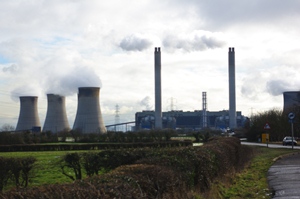Defra study suggests progress on air quality is stalling
A study published by Defra reveals air pollution in the UK shows long term improvement but little change in the past few years, writes Amy North.
Progress in tackling air pollution in the UK appears to be stalling, according to the latest figures published by Defra.
The figures were published in a report on April 26 2012 called ‘Air quality statistics in the UK, 1987 to 2011’. It notes long term improvement in particulate pollution, particularly in urban areas, but states that little has changed recently.
The report shows that in 1992 average urban background particulate pollution was 35 micrograms per cubic metre (mpcm). This declined to 19mpcm in 2008 and in four years has only changed slightly, rising to 20mpcm in 2010 where it has remained.
Ozone is a gas made up of three oxygen atoms which in the upper level of Earth’s atmosphere creates a protective layer however in the lower level it can prove harmful to plants, animals and people.
It explains that the reason for studying the concentration of particulates and ozone is because these are the two pollutants thought to have the greatest health impacts.
Ozone
It also notes an increase of over 50% in the amount of urban background ozone pollution which went up from 38mpcm in 1987 to 58mpcm in 2011.
However the report states that there are a number of factors that affect the level of particulate and ozone in the atmosphere including the weather which could have a significant effect on the figures.
It states: “The relationships between emissions and air quality is complex and strongly affected by the weather. In addition UK air quality can be affected by pollutants blown across from mainland Europe. Day-to-day changes in the weather have a great influence on air quality.
“The gas ozone is not emitted directly in significant quantities, but it created in the air through chemical reactions between other precursor pollutants when in sunlight, with more being created on hot, still, sunny days.”
Figures
The figures presented in the report are a result of monitoring by the Automatic Urban and Rural Network (AURN) which captures ambient concentrations of the selected pollutants through its national network of monitoring sites.
A Defra spokesperson told AirQualityNews: “Air quality in the UK has now improved significantly and is generally very good, and almost all of the UK meets EU air quality limits for all pollutants. PM10 levels were brought down to this level in 2000 following extensive work to reduce air pollution, and work is ongoing to reduce PM10 concentrations further.”
Background
Defra is understood to see the background to UK air quality at present as one of ongoing improvements in the regulation of transport emissions which has in particular helped to reduce PM10 emissions from vehicles and to reduce PM10 concentrations in urban areas. This means that there is compliance with PM10 limits for virtually the whole of the UK.
Summing up the findings, the report states:
- Urban background particulate pollution has shown long-term improvement but changed little recently: average concentrations declined from a peak of 35mpcm in 1992 to 20mpcm in 2011. They changed little in the past four years and were also 20mpcm in 2010.
- Roadside particulate pollution has shown long-term improvement but changed little recently: average concentrations declined from a peak of 39mpcm in 1997 to 22mpcm in 2011. They changed little in the past four years and were 22mpcm in 2010.
- Urban background pollution has shown a long-term increase: average concentrations increased from a low of 38mpcm in 1987 to 58mpcm in 2011 and increased from 53mpcm in 2010 after declining from a peak of 61mpcm in 2006.
- Rural background ozone pollution has shown no clear long-term trend and changed little recently: average concentrations increased from a low of 58mpcm in 1987 to 68mpcm in 2011, but changed little in the past five years fluctuating between 60 and 70mpcm after declining from a peak of 74mpcm in 2006.
- Days of moderate or higher air pollution in urban areas have shown a long-term improvement but increased in 2011: average pollution days declined from a peak of 59 days in 1993 to 16 days in 2011, but increased from the lowest recorded level of 8 days in 2010 — driven by an increased in ozone and particulates pollution in urban sites.
- Days of moderate or higher air pollution for rural areas have shown no clear trend but increased in 2011 compared with 2010: average pollution days declined from a peak of 64 days in 2003 to 30 days in 2011, but increased from a low of 22 days in 2010.
Health
The study says it focuses on ozone and particulate concentrations as they are the two pollutants thought to have the greatest health impacts.
It states: “Chronic exposure to particulates contribute to the risk of developing cardiovascular and respiratory diseases, and there is increasing evidence suggesting that long-term exposure to even low levels of particulates may have a significant effect on health.
“It [ozone] can affect people’s health and can damage wild plants, crops, forests and some materials. The impact of long term exposure to this gas is currently unclear, but if there is no lower limit on the levels which have a health impact then the average concentrations may give a reasonable indication of the level of exposure.”







 Network
Network
